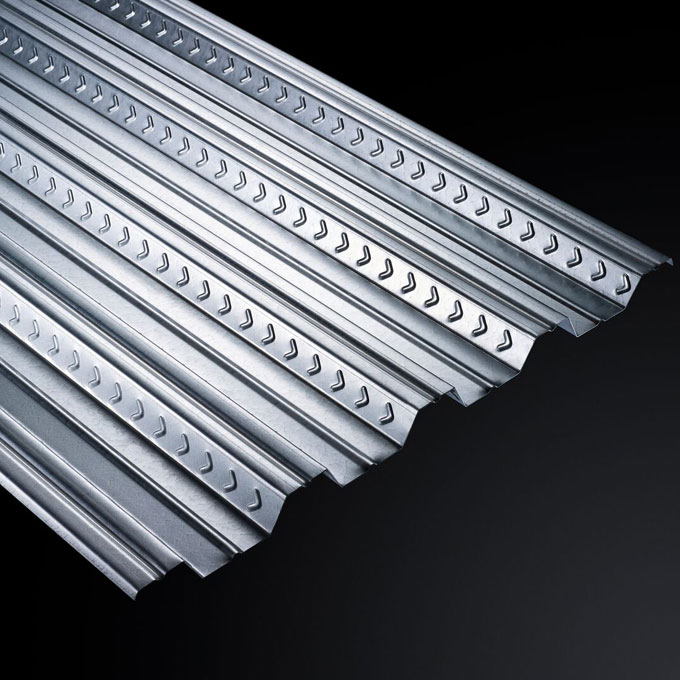ComFor Brochure
Brochure | English
Express Delivery...
Advantages Of Steel Decking...
Metfloor Concrete Volume Calculator...

ComFlor® 46 was our first composite flooring profile, introduced in the early 1980s and is still popular today for its primary characteristics of being nestable, easily transported, simple and efficient.
Classic composite flooring profile, easily transported, simple and efficient
ComFlor® 46 was our first composite flooring profile, introduced in the early 1980s and is still popular today for its primary characteristics of being nestable, easily transported, simple and efficient.
Key benefits are:
Our Load Span tables are designed to optimise the span in the construction stage, with the minimum amount of anti-crack reinforcement required by the relevant design code, while also considering the minimum requirements for the various imposed loading and fire resistance periods.
For more information on our ComFlor® 46 Load Span parameters see our Downloads tab.
See our other products in our ComFlor range:
| ComFlor® 46 (S280) Section properties (per metre width) | |||||||||
|---|---|---|---|---|---|---|---|---|---|
| Nominal thickness (mm) | Design thickness (mm) | Cross section area (mm2/m) | Profile weight (kN/m2) | Height to neutral axis (mm) | Moment of inertia (cm4/m) | Ultimate moment capacity (kNm/m) | |||
| Sagging | Hogging | Sagging | Hogging | ||||||
| 0.9 | 0.86 | 1137 | 0.09 | 20.38 | 41.5 | - | 4.63 | 4.67 | |
| 1.2 | 1.16 | 1534 | 0.13 | 20.44 | 53 | - | 5.99 | 6.23 | |
Section properties in the above table conform to BS 5950.
Design notes:
Deck material
Tata Steel Galvatite®, hot dip zinc coated steel to BS EN 10346 S280GD+Z275, with guaranteed minimum proof strength of 280N/mm2 and zinc coating of total mass 275g/m2 (including both sides). This is sufficient for internal floors in a non-aggressive environment, which satisfies the requirement in clause 4.2 BS EN 1994-1-1 - the exposed surfaces of the steel decking shall be adequately protected to resist the particular atmospheric conditions. A zinc coating, if specified, should conform to the requirements of BS EN 10346. The specification may be varied, depending on service conditions.
Anti-crack mesh
As a minimum requirement where the control of crack width is of no interest, BS EN 1994-1-1, 9.8.1(2) recommends that, where continuous slabs are designed as simply-supported in accordance with BS EN 1994-1-1, 9.4.2(5), the cross-sectional area of the anti-crack reinforcement above the ribs should be not less than 0.2% of the cross-sectional area of the concrete above the ribs for un-propped construction, and 0.4% of this cross-sectional area for propped construction. The mesh specified in the quick reference Eurocode tables, complies with this clause.
Where forklift truck (or other similar concentrated loading) is expected, 0.5% minimum percentage reinforcement should be used over the supports and the previous stated percentages elsewhere to control cracking. For further information refer to SCI AD150.
In accordance with Steel Construction Institute (SCI) P300 ‘Composite Slabs and Beams Using Steel Decking: Best Practice for Design and Construction, a nominal cover of 25mm is stated for an exposure level XC1, for all concrete cylinder strengths for both normal (C25/30 to C40/50) and lightweight concrete (LC25/28 to LC32/35). This nominal cover of 25mm is the minimum cover of 15mm plus a fixing tolerance of 10mm.
ComFlor® 46 Composite slab - volume and weight (BS values)
| Weight of concrete (kN/m²) | |||||
|---|---|---|---|---|---|
| Slab Depth (mm) | Concrete Volume (m³/m²) | Normal Weight Concrete | Lightweight Concrete | ||
| Wet | Dry | Wet | Dry | ||
| 96 | 0.077 | - | - | 1.43 | 1.35 |
| 106 | 0.087 | 2.04 | 2 | 1.61 | 1.53 |
| 110 | 0.091 | 2.13 | 2.09 | 1.69 | 1.6 |
| 120 | 0.101 | 2.37 | 2.32 | 1.88 | 1.78 |
| 130 | 0.111 | 2.6 | 2.55 | 2.06 | 1.95 |
| 140 | 0.121 | 2.84 | 2.78 | 2.25 | 2.13 |
| 150 | 0.131 | 3.08 | 3.01 | 2.43 | 2.31 |
| 160 | 0.141 | 3.31 | 3.24 | 2.62 | 2.48 |
| 170 | 0.151 | 3.55 | 3.47 | 2.81 | 2.66 |
| 180 | 0.161 | 3.78 | 3.7 | 2.99 | 2.84 |
| 190 | 0.171 | 4.02 | 3.93 | 3.18 | 3.01 |
| 200 | 0.181 | 4.25 | 4.16 | 3.37 | 3.19 |
| 250 | 0.231 | 5.43 | 5.32 | 4.3 | 4.07 |
Notes:
1. Deck and beam deflection (ie, ponding) is not included in the table.
2. Deck and mesh weight is not included in the weight of concrete figures.
3. British Standard density of concrete is taken as:
Normal weight (wet) 2400 kg/m3
Normal weight (dry) 2350 kg/m3
Lightweight (wet) 1900 kg/m3
Lightweight (dry) 1800 kg/m3
Brochure | English
Load span tables | English
Detail Drawings | English
Brochure | English
Approval or Certificate | English
Approval or Certificate | English
Brochure | English
We are here to help if you need support. Whether it's choosing the right product for you, checking measurements or anything else.
Feel free to Contact us or call our friendly and knowledgable team on 01335 347629